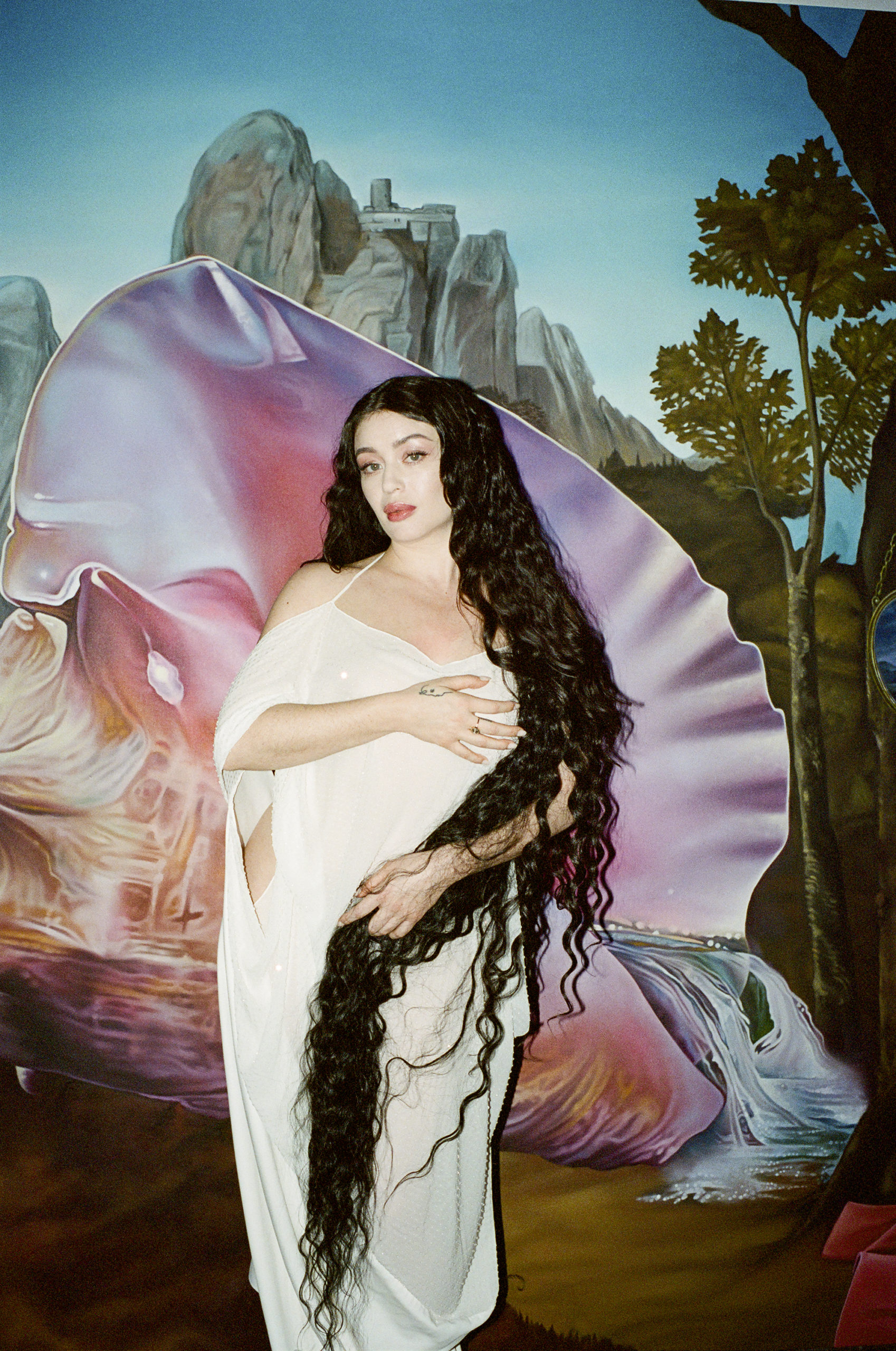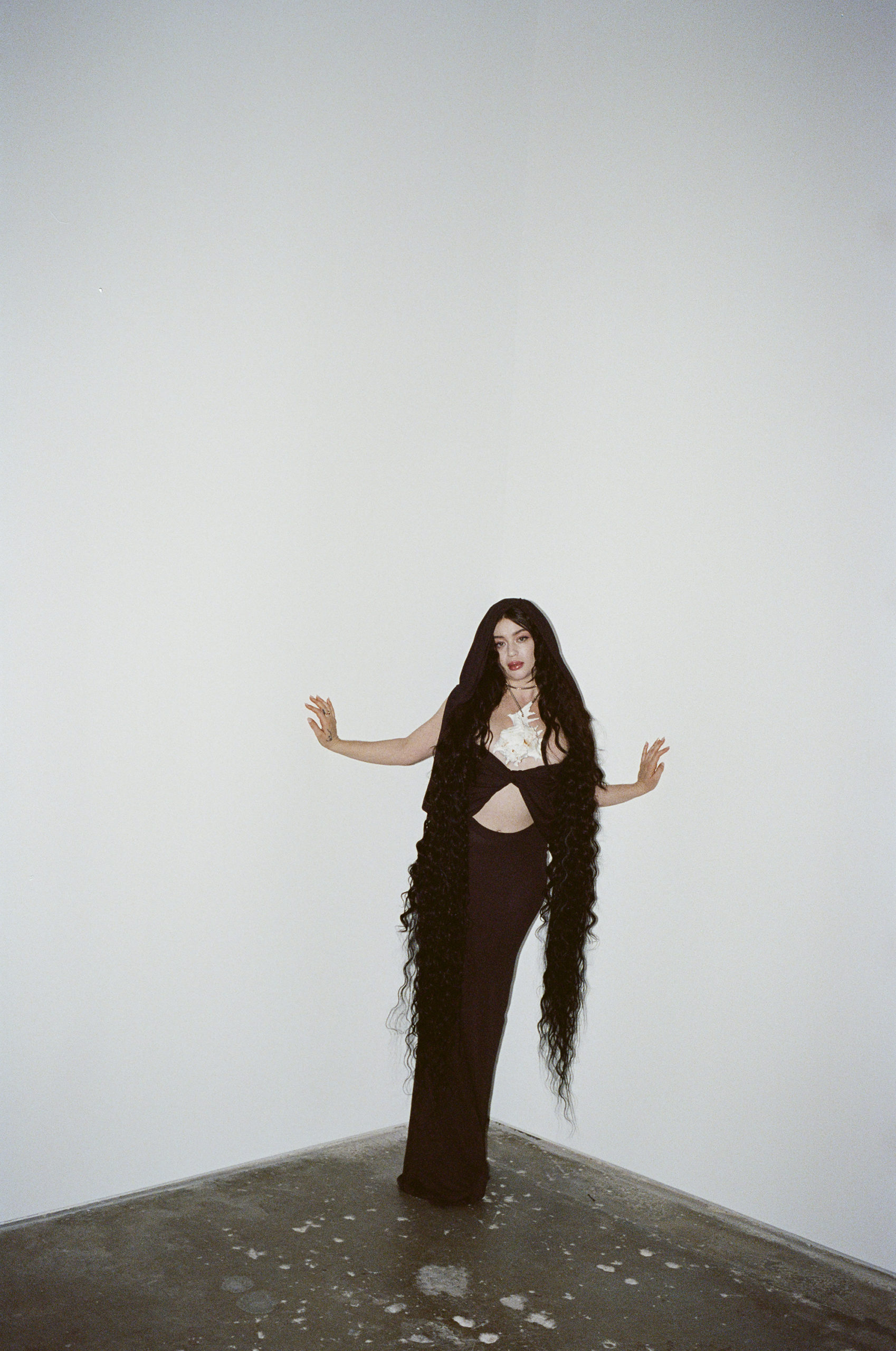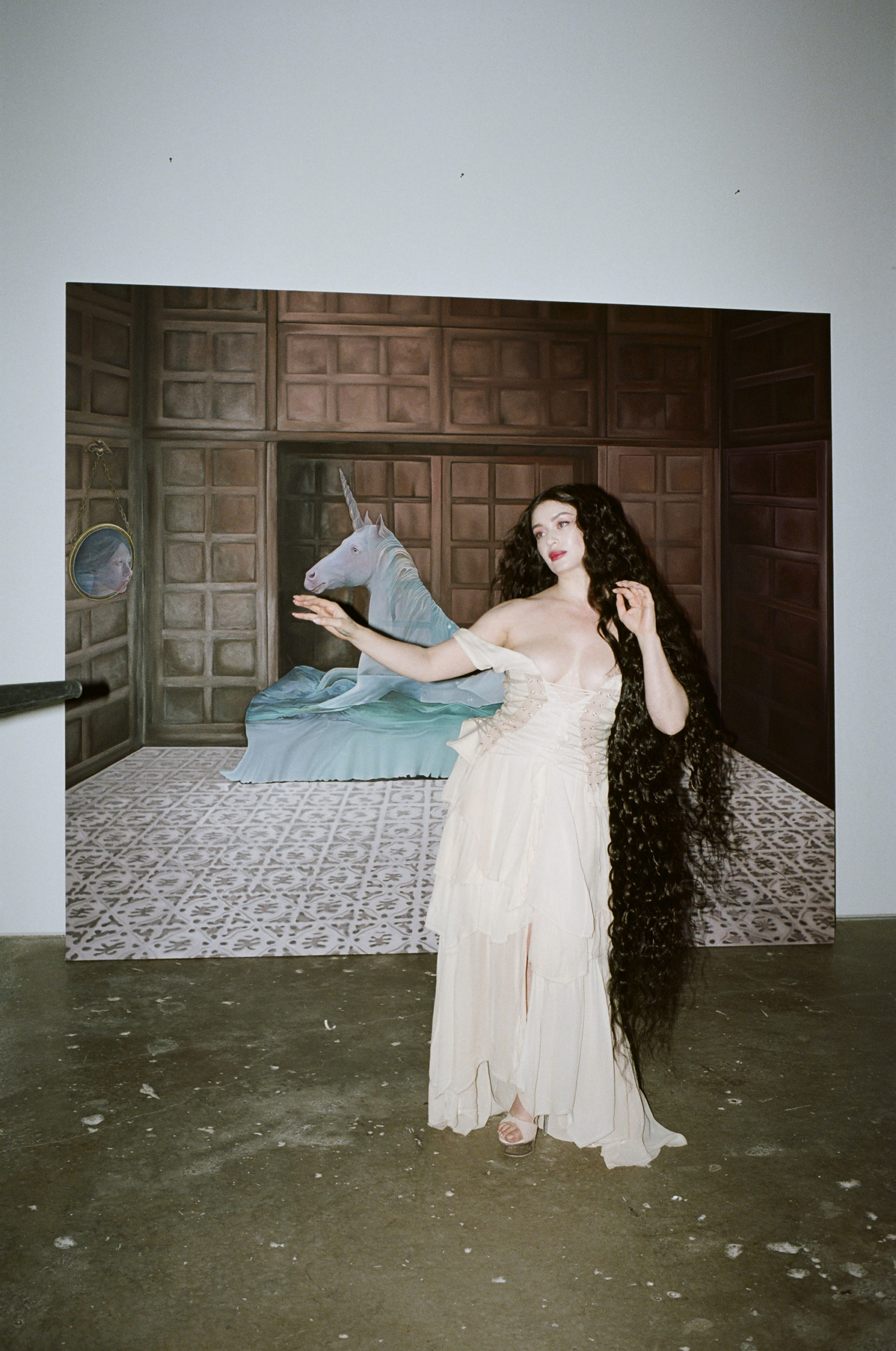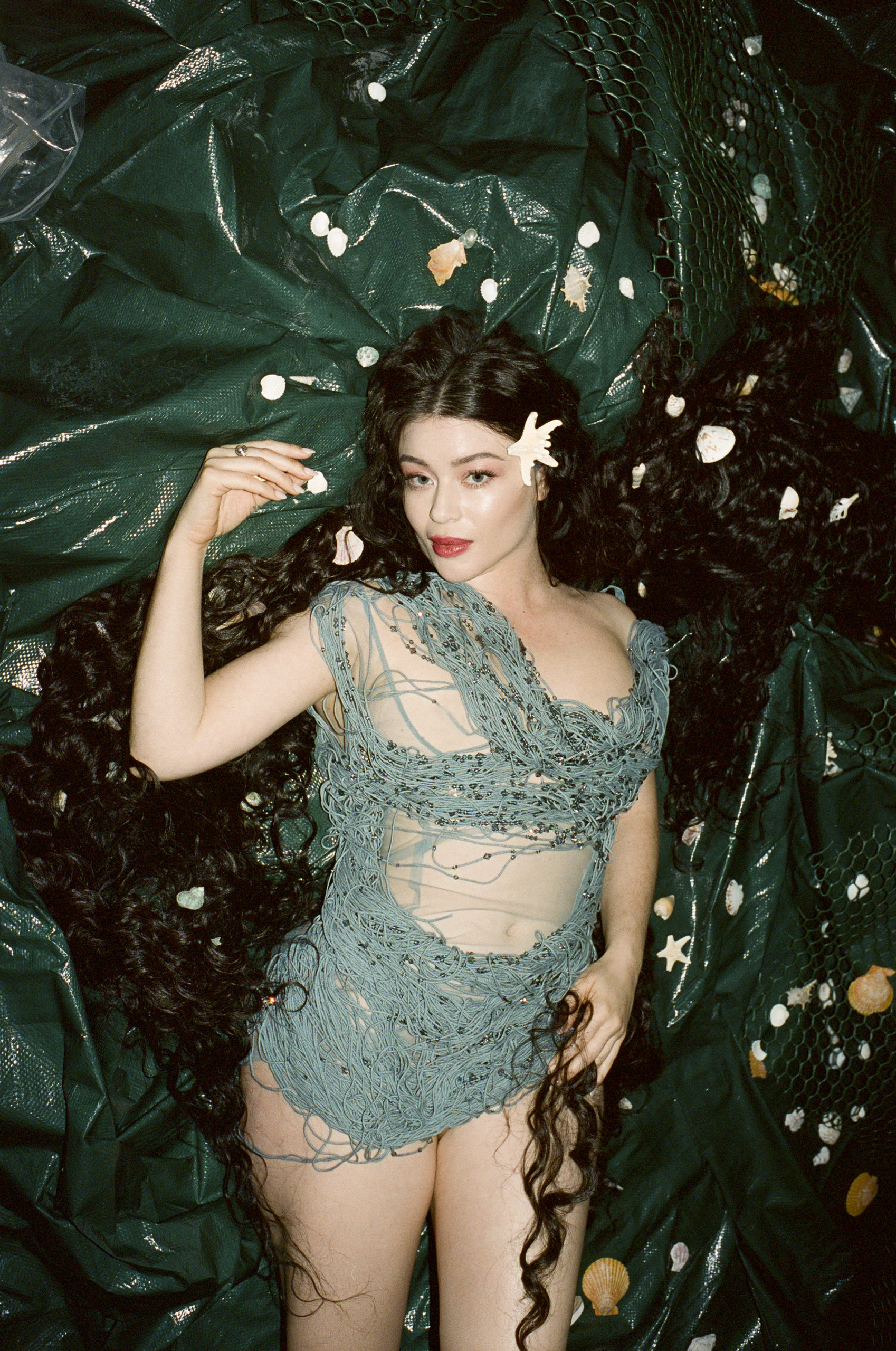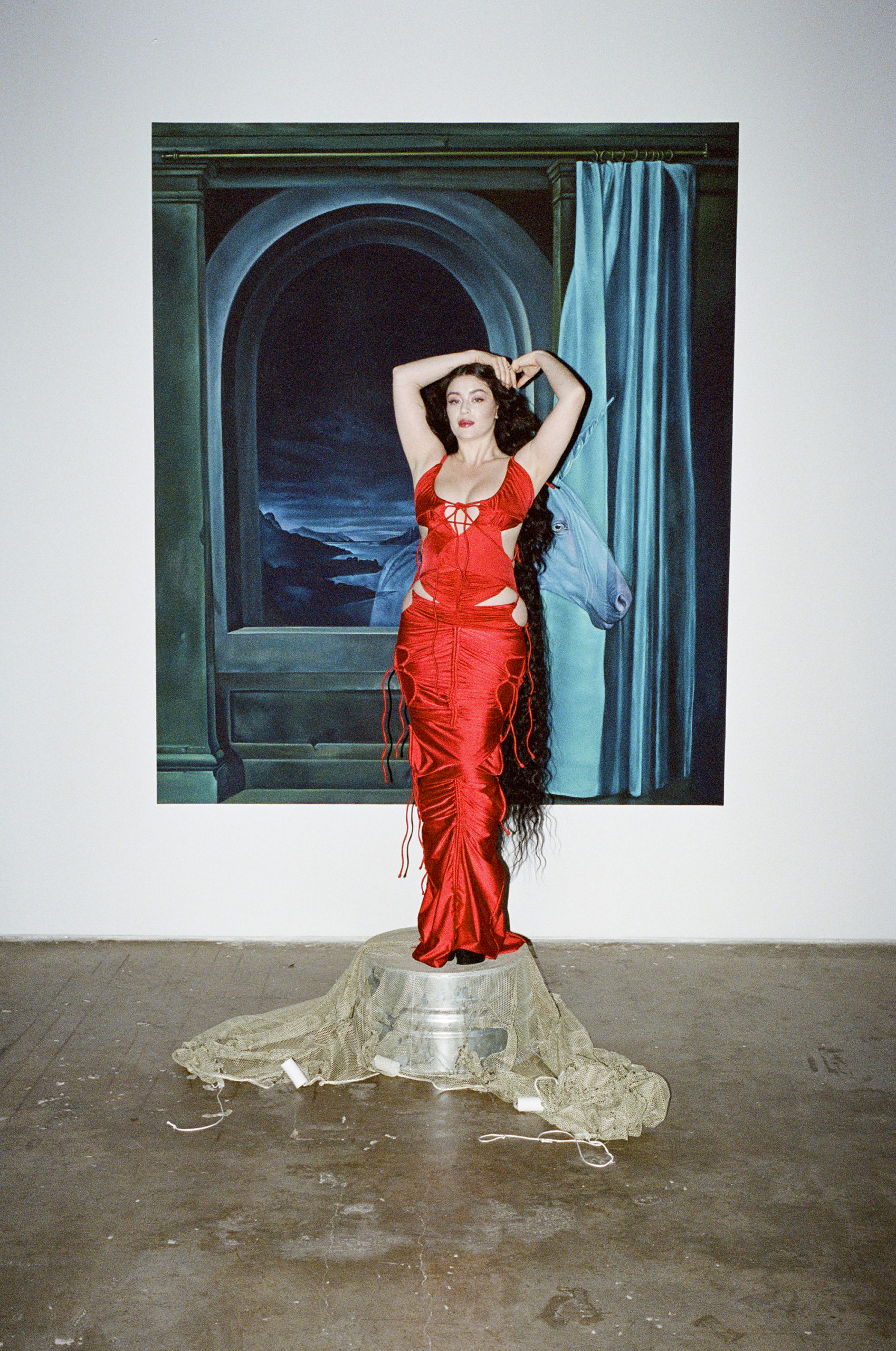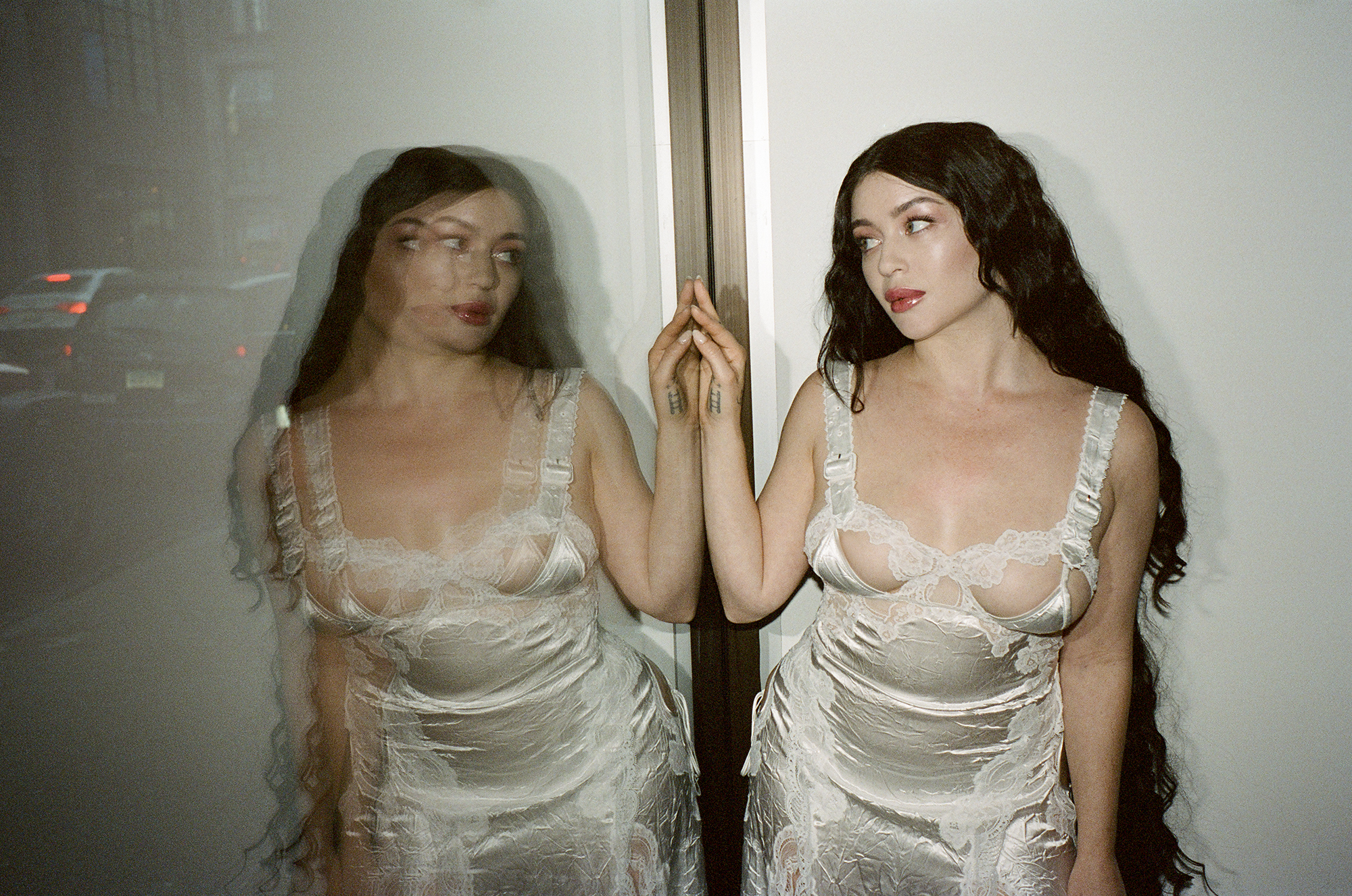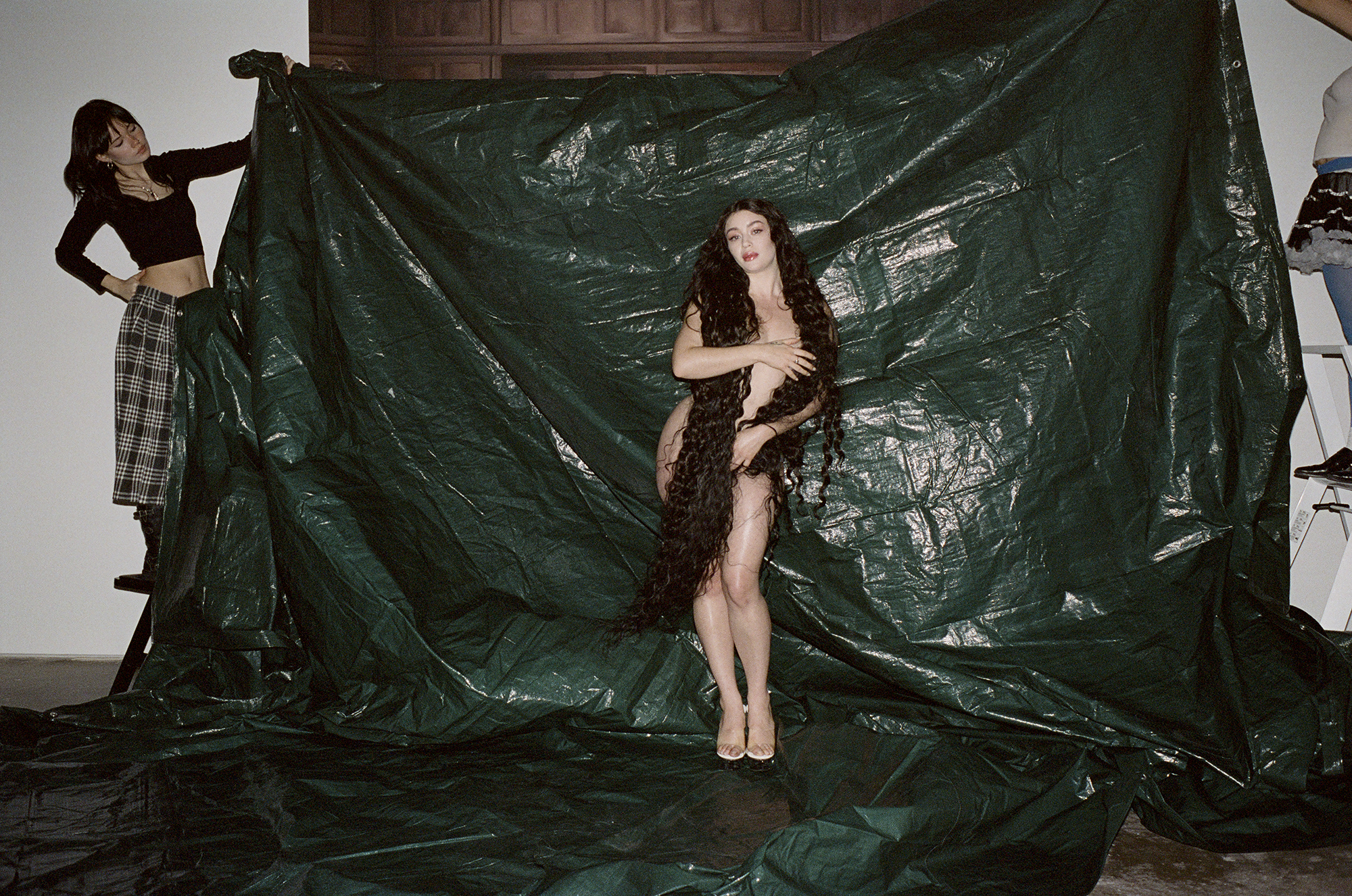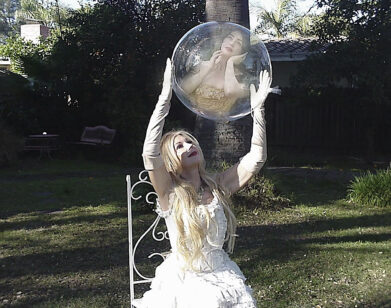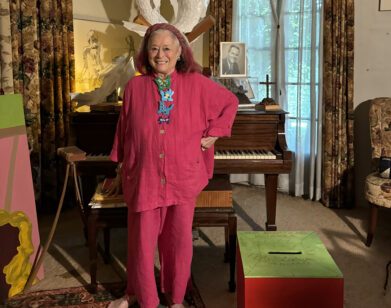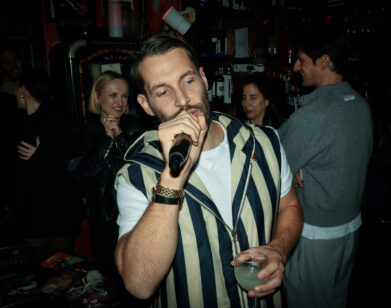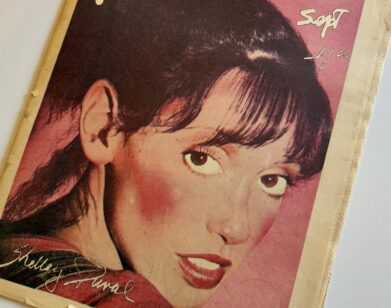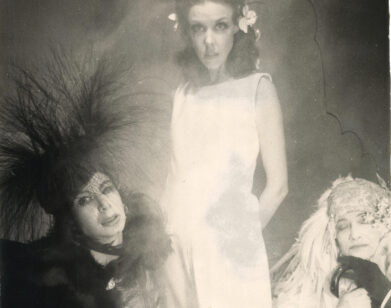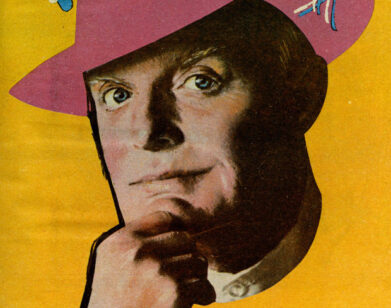PAINTER
Ariana Papademetropoulos Paints (and Parties) Like the World Is Ending
TUESDAY 12 PM DEC. 20, 2022 NYC
Los Angeles–based painter Ariana Papademetropoulos, one of today’s leading artists for a new wave of American surrealism, is on a stopover in New York City. She’s at Vito Schnabel Gallery, where last winter she opened her second solo show with a wild menagerie of unicorns. Today she’s there to chat with Interview impresario Bob Colacello, who arrives on time and spent the next hour speaking to Ariana about making multiple worlds, growing up on two sides of Los Angeles, and lounging in bed at the Louvre.
— — —
BOB COLACELLO: You’ve gotten a lot of press the last few years.
ARIANA PAPADEMETROPOULOS: Maybe. But I’m nervous about what you’re reading.
COLACELLO: I think your work lends itself to literary and philosophical discourse. Writers have a good time with your work.
PAPADEMETROPOULOS: That’s better for me because I feel like I’m just the conduit. I’d rather have it be interpreted. When people write about my work, I realize things I didn’t know about it before.
COLACELLO: Really good art should be open to many interpretations.
PAPADEMETROPOULOS: Yeah. I try to keep my images in this in-between state so depending on the viewer’s psychology, the work can be seen in a different way.
COLACELLO: I like to start at the beginning. You were born in Los Angeles. I saw that your father was an architect in Venice Beach, and your mother lives in Pasadena. That’s quite a contrast.
PAPADEMETROPOULOS: Totally.
COLACELLO: Pasadena is known to be very conservative. It was a bastion of the John Birch Society way before your time in a very square, WASPy enclave. I don’t know if you know who I mean by Betsy Bloomingdale, Nancy Reagan’s best friend. She said that she and her husband, Alfred, made a vow when they married that they would never go to Pasadena. They lived in Bel Air.
PAPADEMETROPOULOS: Oh, I’m the opposite. I want to end up in Pasadena.
COLACELLO: You shuttled back and forth from those two points in L.A.?
PAPADEMETROPOULOS: Yeah, and it definitely had a big influence on my work. Ever since I was little, I was really into decorating. So in Pasadena, I had a very traditional bedroom, and in Venice, I wanted rainbow wallpaper from the ’60s. I assumed these different roles in these different places. One is very country club and the other one was wild. That’s how L.A. is—having one world here and the other world there.
COLACELLO: Was it Brecht who said Los Angeles was seven suburbs in search of a city?
PAPADEMETROPOULOS: I like Los Angeles for that reason. I love going to estate sales and seeing how people decorate their homes. It’s an installation in some ways. I feel like estate sales in L.A. are different because of the way that people create their environment to have their own persona.
COLACELLO: Do you know about Billy Haines? He was a silent actor who became the decorator for Hollywood stars like Joan Crawford, and for socialites like Betsy Bloomingdale. He was very in with the Reagan group and he created this Hollywood Regency style.
PAPADEMETROPOULOS: Oh yeah, I know who you mean.
COLACELLO: Tom Ford now owns Betsy Bloomingdale’s house, and I’m dying to see what he’s done with it. It had been a 1920s Spanish-style house, typical L.A., and then Billy Haines transformed it into a Palladian villa around the courtyard. It was really special.
PAPADEMETROPOULOS: Wow.
COLACELLO: What school did you go to?
PAPADEMETROPOULOS: I went to lots of schools, because I wasn’t the best child. I was a terror.
COLACELLO: Holy terror!1
PAPADEMETROPOULOS: I got kicked out of a lot of schools, but it was probably for the best. I moved to Buenos Aires when I was 17 to finish school. I dropped out of there, too. But once I got to college, I was good.
COLACELLO: You went to CalArts.
PAPADEMETROPOULOS: It was very conceptual starting in the ’70s. And when I went to CalArts, I was the only painter at the time in my class. I was a rebel by painting.
COLACELLO: You were always doing realistic painting?
PAPADEMETROPOULOS: Yeah. They didn’t want me to, but I did. And now it’s quite in fashion.
COLACELLO: In the ’70s when I was working with Warhol, he was ostracized for doing figurative art which in many cases were commissioned portraits by society people, and that was totally out. A lot of the intellectual side of the art world snubbed Andy; they wouldn’t hang his work at MoMA. Then suddenly in 1980, you have this generation coming out of art schools—Julian Schnabel, Eric Fischl, Francesco Clemente, the Germans—they lumped them together as neo-Expressionist but they all were painting in their own very distinctive way. Basquiat, Haring—you can’t kill painting. I think it’s been pronounced dead many times.
PAPADEMETROPOULOS: It’ll always come back. Even now, I paint similar stuff to what I was painting in high school. I think I’ve come back to the things I painted when I was young. But at CalArts, I moved away from it. Because they were a bit judgmental when it came to figuration.
COLACELLO: It’s almost puritanical. Minimalism is the only acceptable painting.
PAPADEMETROPOULOS: I think if they had let me paint, I might have not been so adamant about painting. It was like I wanted to prove a point.
COLACELLO: Were you already, at that age, looking at old Renaissance paintings?
PAPADEMETROPOULOS: That’s why I’ve been so interested in traveling to Italy in recent years. I didn’t have that education in art history before 1900. That’s a newfound interest of mine.
COLACELLO: Who would you consider your influences?
PAPADEMETROPOULOS: Definitely female surrealists from the ’30s and ’40s. Remedios Varo, Dorothea Tanning, Leonora Carrington. I’m most connected to those artists because I do think that female surrealism is very different from male surrealism. Male surrealism is just absurdity. I put Max Ernst in the female surrealist in a way because it’s based on esoteric knowledge. There’s a lot of symbolism in there. It’s not just absurdity for the sake of it.
COLACELLO: I’m thinking of Dali.
PAPADEMETROPOULOS: And I love Dali. But I feel like when people think of surrealism, they think of Dali. And there’s so much more to it.
COLACELLO: What about Frida Kahlo?
PAPADEMETROPOULOS: Oh, I love her. I love everything about her, her clothing, everything.
COLACELLO: When you graduated you worked with different artists. Who was your first mentor?
PAPADEMETROPOULOS: Noah Davis. He started The Underground Museum. He taught me so much about painting in terms of scale and ethic and to always work with your friends and have a community around you. I worked for him and for Jonah Freeman and Justin Lowe and Marnie Weber and Jim Shaw. I think I learned more from working for artists than I did from actual school, probably.
COLACELLO: That’s usually a good thing to do. Your work has been called everything from esoteric to bombastic—
PAPADEMETROPOULOS: What does that word even mean?
COLACELLO: It means like ultra bold.
PAPADEMETROPOULOS: Oh. I try to be more subtle. I don’t think I want to be bold.
COLACELLO: Trump is bombastic. I don’t think you are.
PAPADEMETROPOULOS: I always try to strip the paintings down. I know I go too far into the magic and then I pare them down a bit.
COLACELLO: L.A. has a tradition of magic, of cults. People always went to L.A. to reinvent themselves. People went to become movie stars, and the studios gave them new names.
PAPADEMETROPOULOS: It’s a place of transformation.
COLACELLO: But it’s sad that there are more artists working in L.A. than in New York now, because it’s much more affordable.
PAPADEMETROPOULOS: Not anymore. Because everybody moved to L.A., now the tables have turned. But I suppose you get a house and you get a garden. It’s the lifestyle. I’m a bit over it because I’ve been there for so long. But it’s true, in L.A. there are endless possibilities. There isn’t that same sentiment in Europe. There are more rules.
COLACELLO: A lot of New Yorkers in the ’60s and ’70s looked down on L.A. I’ve always felt that L.A. is the ultimate horizontal city. And New York’s the ultimate vertical city.
PAPADEMETROPOULOS: I like how endless L.A. is. There’s always a new place to discover. There’s always something I don’t know.
COLACELLO: Correct me if I’m wrong, but your current paintings are more rooted in classicism rather than surrealism. And they’re simpler in a sense.
PAPADEMETROPOULOS: Yeah. There’s a lot going on but they’re also quite empty.
COLACELLO: It’s like there’s a lavender wash over everything in the show.
PAPADEMETROPOULOS: It’s true. I wanted it to all feel like it was at a certain time of day. It’s supposed to be twilight, maybe 5 a.m. or right before the sun is up. Or moonlight. Yeah.
COLACELLO: You’ve spent some time recently in Rome and Paris.
PAPADEMETROPOULOS: I was just in Paris last week. I shot a film with the Louvre which was pretty wild.
COLACELLO: I like the film you did for Vito [Schnabel]’s show where you’re on the bed. Where was that shot?
PAPADEMETROPOULOS: Milos. The island in Greece where the Venus de Milo statue was originally from.
COLACELLO: I first thought the white in the video was snow. But I realized it was limestone or chalk.
PAPADEMETROPOULOS: Because it’s a volcanic island, so there’s a lot of white on everything. I’m doing a trilogy of bed films. In the latest one, I’m on a bed traveling through the Louvre. There are wheels on it and there I am going by the Mona Lisa.
COLACELLO: Did you have to get a permit?
PAPADEMETROPOULOS: The Louvre actually asked me to do it as part of their contemporary programming. And I thought, what would be the dream at the Louvre? And I was like, “Oh, to be in bed and look at all the paintings.”
COLACELLO: So that’s the second bed film. Can you reveal where the third one will be?
PAPADEMETROPOULOS: Well, I want to do it when I’m 80. I want to have a bed hanging from a flying helicopter when I’ve got less to lose. That would be a good end to the series.
COLACELLO: We have to wait a long time to see it.
PAPADEMETROPOULOS: I thought it’d be fun to wait.
COLACELLO: There was a painting of yours in Vito’s office for a long time of two women, and you can’t really tell what exactly is going on. I thought, “Is she lighting a joint?” Is there some story there?
PAPADEMETROPOULOS: Do you really want to know? It’s from a porno. It’s these two Fräulein Dutch girls giving a blow job to a priest.
COLACELLO: Where was the priest in this?
PAPADEMETROPOULOS: I took him out. I guess I like playing with images in that way, where some of them will be pornographic, but then I always take the porn out.
COLACELLO: There was something suggestive about it. I want to say the work from that show was more “feminine.” But I wouldn’t call it “feminist.” I don’t know. I hate all these categories.
PAPADEMETROPOULOS: I do too. I think we have to move into a world that has less labels, not more.
COLACELLO: Exactly. And I don’t know if you saw the Netflix series, The Andy Warhol Diaries
PAPADEMETROPOULOS: I did.
COLACELLO: I had a lot of problems with it. I think it was very well done in a lot of ways. But it was so overly obsessed with making Andy a gay artist that it took away from—
PAPADEMETROPOULOS: He’s just an artist.
COLACELLO: At the end of the day. I felt like they were trying to imply that Vincent Fremont and me and Pat Hackett were part of this attempt to deny Andy’s homosexuality. And Andy, when he was asked, “Are you gay?” He would just say, “Well, just look at my films.” Lonesome Cowboys, My Hustler. They were so far ahead of the times. Chelsea Girls. You never saw two guys kissing before Warhol. But he didn’t want to be pinned down. Today people confuse nonchalance about your private life or your sexuality with denial. Nobody was in denial. It just didn’t matter that much.
PAPADEMETROPOULOS: I feel similar, that people always ask, “What do you feel as a female artist?” And my work has to be feminist since I’m a female artist. I just want to be an artist. I’ve refused to be in all-female shows if that’s the premise of the exhibition because I don’t think that’s the way forward. I want to be in a show on the basis of my work.
COLACELLO: Being a woman is part of who you are, but it’s not the whole thing. This focus on groups has been really healthy because it’s brought the focus on artists who have been neglected to a degree, like Joan Mitchell and Pat Steir. Lee Krasner was as good as Jackson Pollock. And it has created space for women artists. Julie Mehretu and Cecily Brown are two of my favorite artists, but it’s not just because they’re women. The originality of their work comes from them as full human beings.
PAPADEMETROPOULOS: That’s what I mean about moving forward rather than backwards. Just being artists, that’s where we’ve got to head towards. We’re in this very strange purgatory right now.
COLACELLO: We do live in crazy times. Whoever thought there would be a land war in Europe again? Or that Donald Trump could become president?
PAPADEMETROPOULOS: It is a strange time and it also feels a bit indulgent to be making art. But we have to.
COLACELLO: It’s a time of surrealism in a way.
PAPADEMETROPOULOS: It really is. I think that’s why surrealism has come back. Our world is so surreal that now people are more open to different possibilities. Especially after the pandemic. We lived in a very linear world, and now people see that the world isn’t as structured as it seemed, so they’re more open.
COLACELLO: And it isn’t as secure.
PAPADEMETROPOULOS: I think it’s making everyone want to enjoy their life a bit more. There’s more indulgence. It’s like having a timeline where all of a sudden you find out you’ve got six months left to live.
COLACELLO: Well, I did just get some gold-leaf macarons.
PAPADEMETROPOULOS: You see? We’ve got to have the gold-leaf macarons.
COLACELLO: We live in a time again where everything’s the opposite of subtle.
PAPADEMETROPOULOS: It’s just that our attention spans have collectively diminished so much that things have to be in your face to get your attention. But I don’t think that good work has to do that. I hope we can gain some brain cells back so we can appreciate things that take more time and are more subtle.
COLACELLO: You work very slowly, don’t you?
PAPADEMETROPOULOS: Yes. I could work faster but I do believe that the magic is in the work. This isn’t true for all artists, but for my work it feels like a crime if I had someone else make them. So I’m going to make 15 great paintings a year.
COLACELLO: I want to ask, what is it about unicorns that so attracts you?
PAPADEMETROPOULOS: I guess the more I researched unicorns, the more I became interested. The unicorn is both male and female. If you take the horn, it can be a cup, but it’s also very phallic. The unicorn is something that’s revered and loved and cherished, but it’s also something that’s alone in this world and hunted. The unicorn is in every mythology. It’s an archetype. You can find them in Chinese culture, in Norse culture, in Russian culture. So it’s universal, a symbol everyone’s been enchanted with. It’s magic.
COLACELLO: To ask you a silly question, who has the best parties in L.A.?
PAPADEMETROPOULOS: I do.
COLACELLO: I was reading about your party at Jeffrey Deitch’s house. That sounded pretty wild.
PAPADEMETROPOULOS: I’ve had really fun parties at Jeffrey’s. One time, I had an elf party where everyone had elf ears on.
COLACELLO: So you like theme parties?
PAPADEMETROPOULOS: I love.
COLACELLO: My motto when it comes to parties is 19 to 91. If I have a party, I like to have that range in ages.
PAPADEMETROPOULOS: Me too. And you’ve got to throw some freaks in there as well.
———
Hair: Sean Bennett using Oribe
Makeup: Rommy Najor Using Shiseido At Forward Artists
Manicure: Mamie Onishi Using Dior
Lighting: Ryan Petrus
Fashion Assistants: Alexandra Harris, A’kai Littlejohn, and Sierra Estep
Location: Vito Schnabel Gallery
———
- Holy Terror: Andy Warhol Close Up is the title of a Colacello-penned biography.

